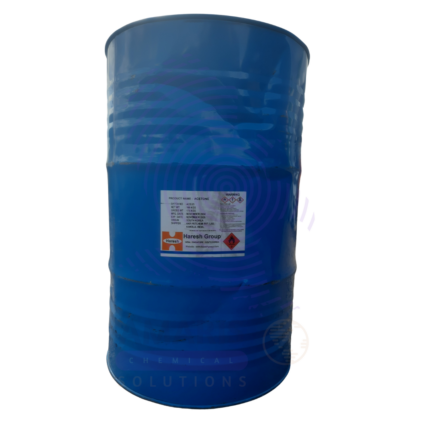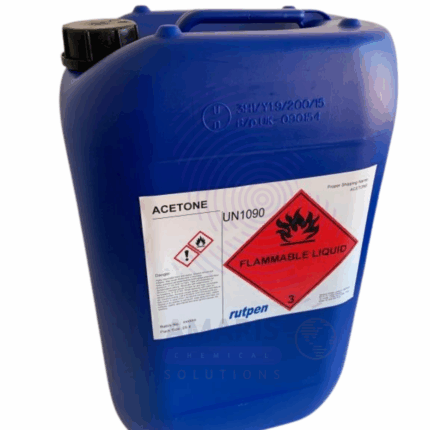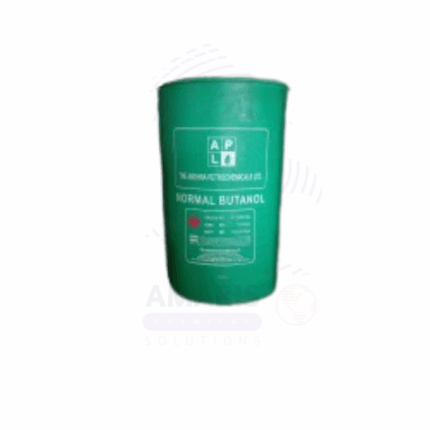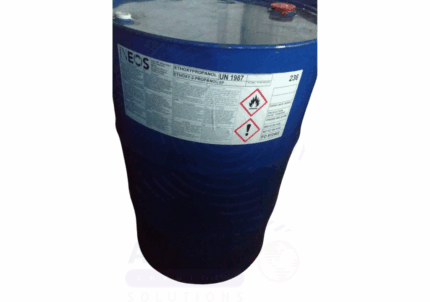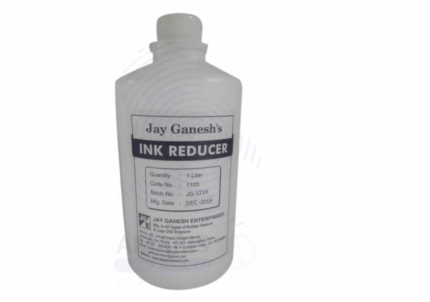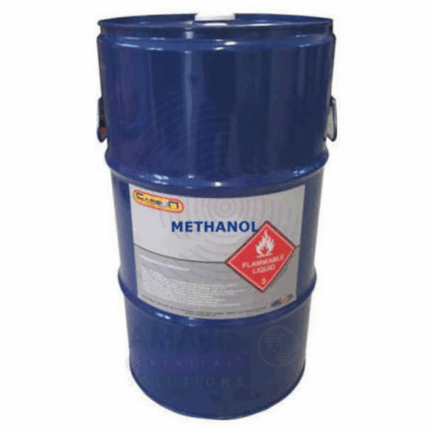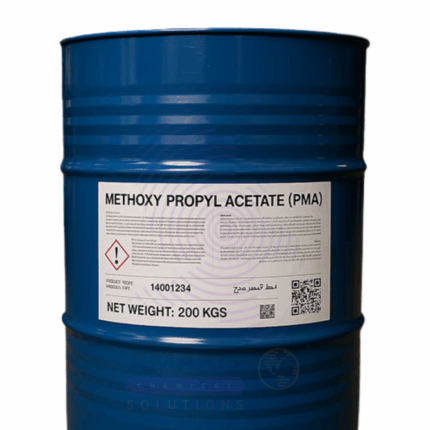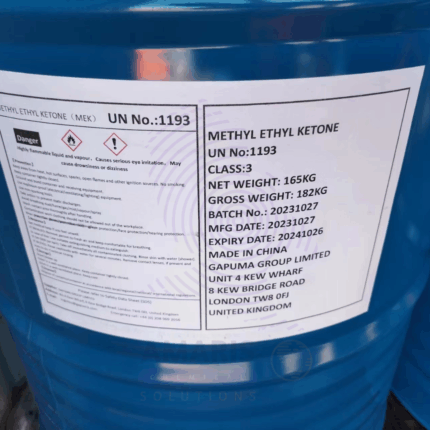
Avocado Wax
$ 4.20 Original price was: $ 4.20.$ 4.08Current price is: $ 4.08.
Ethyl Acetate
$ 3.40 Original price was: $ 3.40.$ 3.29Current price is: $ 3.29.
Whatsapp Order
Ethyl Acetate is a clear, colorless, volatile organic solvent with a characteristic sweet, fruity odor reminiscent of pear drops. It is an ester formed by the condensation of ethanol and acetic acid. Known for its excellent solvency, low toxicity, and rapid evaporation rate, Ethyl Acetate is widely used as a solvent in coatings, adhesives, inks, pharmaceuticals, and chemical synthesis. It is miscible with most organic solvents and partially soluble in water. Ethyl Acetate offers high volatility, making it ideal for quick-drying formulations.
Description
Table of Contents
Toggle
Ethyl Acetate
Primary Uses
- Coatings & Paints
- Used extensively as a solvent in lacquers, varnishes, and automotive and industrial coatings for fast drying and good film formation.
- Enhances leveling and gloss in architectural paints and finishes.
- Adhesives & Sealants
- Serves as a solvent for adhesives including pressure-sensitive adhesives, contact cements, and sealants.
- Facilitates proper viscosity and drying time in adhesive formulations.
- Printing Inks
- Common solvent in solvent-based printing inks for flexible packaging, labels, and commercial printing.
- Helps achieve smooth ink flow and rapid drying on substrates.
- Pharmaceuticals
- Utilized as a solvent or extraction agent in pharmaceutical manufacturing processes.
- Employed in preparation of coatings for tablets and capsules.
- Chemical Intermediates & Extraction
- Acts as an intermediate in organic synthesis reactions.
- Used as an extraction solvent in decaffeination and various laboratory procedures.
- Cosmetics & Personal Care
- Present in nail polish removers and fragrances as a solvent due to its volatility and mild odor.
- Used in certain cosmetic preparations to aid ingredient dispersion.
Secondary Uses
- Food Industry
- Approved as a flavoring agent and solvent in food products under regulated limits.
- Cleaning & Degreasing
- Applied in industrial and electronic cleaning formulations for fast evaporation and residue-free cleaning.
Additional information
| PACK SIZE |
20ltrs |
|---|
KEY PRODUCT FEATURES
1. Basic Identification Attributes
- Chemical Name (IUPAC): Ethyl acetate
- Common/Trade Name: Ethyl Acetate
- CAS Number: 141-78-6
- HS Code: 2915.31.00
- Molecular Formula: C4H8O2
- Synonyms: Ethyl ethanoate, Acetic acid ethyl ester, Acetic ether
2. Physical & Chemical Properties
- Physical State: Clear, colorless liquid
- Odor: Sweet, fruity, characteristic
- Boiling Point: 77.1°C
- Melting Point: -83.6°C
- Density: 0.902 g/cm³ at 20°C
- Flash Point: 12°C (closed cup)
- Vapor Pressure: 97 mmHg at 20°C
- Solubility: Miscible with most organic solvents; partially soluble in water (~8.3% w/w at 20°C)
- Evaporation Rate: Fast
- Vapor Density: 3.0 (air = 1)
- Refractive Index: 1.3727 at 20°C
- Stability: Stable under recommended storage conditions; incompatible with strong acids, bases, and oxidizers.
3. Safety & Hazard Attributes
- Hazard Class (GHS): Flammable liquid – Category 2
- Toxicity: Low acute toxicity; may cause mild irritation to eyes and respiratory tract
- Exposure Limits: OSHA PEL - 400 ppm (1400 mg/m³) TWA
- Flammability: Highly flammable liquid and vapor
4. Storage & Handling Attributes
- Storage Conditions: Store in a cool, dry, well-ventilated area away from heat, sparks, and open flames
- Container Type: Stored in tightly closed metal or glass containers
- Shelf Life: Typically 1–2 years if stored properly
- Handling Precautions: Use explosion-proof equipment; avoid static discharge; ensure good ventilation
5. Regulatory & Compliance Attributes
- FDA Status: Generally recognized as safe (GRAS) for use as a solvent and flavoring agent under regulated conditions
- REACH Registration: Registered and compliant in EU regulations
- VOC Regulations: Regulated as a volatile organic compound in many regions
- Restrictions: Must comply with flammable liquid storage and transportation rules
6. Environmental & Health Impact
- Biodegradability: Readily biodegradable in aerobic conditions
- Ecotoxicity: Moderate toxicity to aquatic life; avoid release to waterways
- Bioaccumulation: Low potential
- Carcinogenicity/Mutagenicity: Not classified as carcinogenic or mutagenic
SAFETY HANDLING PRECAUTIONS
Safety Handling Precautions
PPE Required:
- Flame-resistant gloves
- Safety goggles or face shield
- Protective clothing
- Use respiratory protection if ventilation is inadequate
Handling Guidelines:
- Avoid inhalation of vapors and contact with skin or eyes
- Use grounding and bonding during transfer to prevent static sparks
- Do not smoke or use ignition sources nearby
Storage Measures:
- Store away from oxidizers, acids, and bases
- Keep containers tightly closed and away from heat sources
- Use explosion-proof ventilation systems
Hygiene Practices:
- Wash hands thoroughly after handling
- Avoid eating, drinking, or smoking in work areas
- Clean equipment regularly
First Aid Measures
- Inhalation: Move to fresh air immediately; seek medical attention if symptoms persist
- Skin Contact: Wash with soap and water; remove contaminated clothing; seek medical advice if irritation develops
- Eye Contact: Rinse cautiously with water for 15 minutes; seek medical attention if irritation persists
- Ingestion: Rinse mouth; do not induce vomiting; seek medical help immediately
Firefighting Measures
- Fire Hazards: Highly flammable liquid and vapor; vapors may form explosive mixtures with air
- Extinguishing Media: Use foam, dry chemical, CO₂, or water spray
- Special Precautions: Wear full protective gear and self-contained breathing apparatus
- Decomposition Products: Carbon oxides, acetaldehyde, and other toxic fumes
Related products
Acetone
Acetone Extra Pure is a high-purity grade of acetone (≥99.5%) specifically purified to meet stringent quality standards for laboratory and industrial applications. This volatile, colorless solvent is characterized by its rapid evaporation rate, excellent solvency power, and minimal impurity content, making it suitable for sensitive chemical processes and analytical applications
Butanol
Butanol (also known as n-Butanol or Normal Butanol) is a clear, colorless liquid with a mild, alcoholic odor. It is a four-carbon primary alcohol with the chemical formula C4H10O. Butanol is moderately soluble in water and miscible with many organic solvents. Its physical and chemical properties make it a versatile solvent and chemical intermediate. Butanol indicates a high purity grade often used in industrial, pharmaceutical, and chemical synthesis applications.
Ethoxy Propanol
Ethoxy Propanol, also known as Propylene Glycol Monoethyl Ether (PnP), is a clear, colorless, low-viscosity solvent with a mild ether-like odor. It belongs to the family of glycol ethers and is miscible with water and most organic solvents. Ethoxy Propanol is widely valued for its excellent solvency, moderate evaporation rate, and compatibility with both polar and non-polar systems. It is extensively used in coatings, inks, cleaners, and chemical synthesis applications due to its balance of performance and safety.
Ethyl Glycol Acetate
Ethyl Glycol Acetate, also known as 2-Ethoxyethyl acetate, is a clear, colorless liquid solvent with a mild, sweet, and slightly fruity odor. It belongs to the family of glycol ethers and esters, combining excellent solvency power with moderate evaporation rates. This makes it highly suitable for use in coatings, inks, adhesives, and cleaning formulations where good solvency and controlled drying times are desired. Ethyl Glycol Acetate is compatible with a wide range of resins, including nitrocellulose, alkyd, acrylic, and vinyl resins, making it a versatile industrial solvent. Its balanced physical properties allow for efficient thinning, cleaning, and dissolution without rapid evaporation or harsh odors.
Ink reducer (Ethanol)
Ink reducer (Ethanol) is a volatile, colorless liquid used to adjust the viscosity, flow, and drying time of printing inks. Composed primarily of high-purity ethanol (ethyl alcohol), it acts as a solvent or diluent in various ink systems—particularly in flexographic, gravure, and screen printing. This reducer enhances printability by improving ink transfer, leveling, and penetration into substrates. Ink reducers based on ethanol are fast-drying and widely compatible with alcohol-soluble and water-alcohol hybrid inks used in packaging, label printing, and paper conversion industries.
Methanol
$ 1.15
Methanol, also known as methyl alcohol or wood alcohol, is a clear, colorless, volatile, and flammable liquid with a distinct alcoholic odor. It is the simplest alcohol and is widely used as an industrial solvent, antifreeze, fuel, and chemical feedstock. Methanol is highly miscible with water and many organic solvents and serves as a precursor to numerous chemicals including formaldehyde, acetic acid, and various plastic
Methoxy Propyl Acetate
Methoxy Propyl Acetate is a clear, colorless liquid solvent with a mild fruity odor. It is an ester derived from methoxy propanol and acetic acid, widely used in coatings, inks, adhesives, and cleaning products due to its excellent solvency, moderate evaporation rate, and good compatibility with various resins. PMA offers low volatility and strong solvency for a broad range of materials, making it ideal for industrial and commercial applications.
Methyl Ethyl Ketone
Methyl Ethyl Ketone, also known as Butanone, is a clear, colorless liquid with a sharp, sweet odor. It is a highly effective solvent widely used in industrial processes due to its excellent solvency, fast evaporation rate, and compatibility with a wide range of substances. MEK is commonly used in coatings, adhesives, printing inks, and cleaning formulations.


 Preservatives(food)
Preservatives(food) Flavor Enhancers
Flavor Enhancers Acidulants
Acidulants Sweeteners
Sweeteners Antioxidants
Antioxidants Colorants(food)
Colorants(food) Nutraceutical Ingredients (food)
Nutraceutical Ingredients (food) Nutrient Supplements
Nutrient Supplements Emulsifiers
Emulsifiers
 Collectors
Collectors Dust Suppressants
Dust Suppressants Explosives and Blasting Agents
Explosives and Blasting Agents Flocculants and Coagulants
Flocculants and Coagulants Frothers
Frothers Leaching Agents
Leaching Agents pH Modifiers
pH Modifiers Precious Metal Extraction Agents
Precious Metal Extraction Agents
 Antioxidants(plastic)
Antioxidants(plastic) Colorants (Pigments, Dyes)
Colorants (Pigments, Dyes) Fillers and Reinforcements
Fillers and Reinforcements Flame Retardants
Flame Retardants Monomers
Monomers Plasticizers
Plasticizers Polymerization Initiators
Polymerization Initiators Stabilizers (UV, Heat)
Stabilizers (UV, Heat)
 Antifoaming Agents
Antifoaming Agents Chelating Agents
Chelating Agents Coagulants and Flocculants
Coagulants and Flocculants Corrosion Inhibitors
Corrosion Inhibitors Disinfectants and Biocides
Disinfectants and Biocides Oxidizing Agents
Oxidizing Agents pH Adjusters
pH Adjusters Scale Inhibitors( water)
Scale Inhibitors( water)
 Antioxidants(cosmetic)
Antioxidants(cosmetic) Emollients
Emollients Fragrances and Essential Oils
Fragrances and Essential Oils Humectants
Humectants Preservatives
Preservatives Surfactants(cosmetic)
Surfactants(cosmetic) Thickeners
Thickeners UV Filters
UV Filters
 Fertilizers
Fertilizers Soil Conditioners
Soil Conditioners Plant Growth Regulators
Plant Growth Regulators Animal Feed Additives
Animal Feed Additives Biostimulants
Biostimulants Pesticides (Herbicides, Insecticides, Fungicides)
Pesticides (Herbicides, Insecticides, Fungicides)
 Active Pharmaceutical Ingredients (APIs)
Active Pharmaceutical Ingredients (APIs) Excipients
Excipients Solvents(pharmaceutical)
Solvents(pharmaceutical) Antibiotics
Antibiotics Antiseptics and Disinfectants
Antiseptics and Disinfectants Vaccine Adjuvants
Vaccine Adjuvants Nutraceutical Ingredients (pharmaceutical)
Nutraceutical Ingredients (pharmaceutical) Analgesics & Antipyretics
Analgesics & Antipyretics
 Analytical Reagents
Analytical Reagents Solvents(lab)
Solvents(lab) Chromatography Chemicals
Chromatography Chemicals Spectroscopy Reagents
Spectroscopy Reagents microbiology-and-cell-culture-reagents
microbiology-and-cell-culture-reagents Molecular Biology Reagents
Molecular Biology Reagents Biochemical Reagents
Biochemical Reagents Inorganic and Organic Standards
Inorganic and Organic Standards Laboratory Safety Chemicals
Laboratory Safety Chemicals Specialty Laboratory Chemicals(Special Laboratory Equipment)
Specialty Laboratory Chemicals(Special Laboratory Equipment)
 Demulsifiers
Demulsifiers Hydraulic Fracturing Fluids
Hydraulic Fracturing Fluids Scale Inhibitors(oil)
Scale Inhibitors(oil) Surfactants(oil)
Surfactants(oil) Drilling Fluids
Drilling Fluids
 Dyes and Pigments
Dyes and Pigments Bleaching Agents
Bleaching Agents Softening Agents
Softening Agents Finishing Agents
Finishing Agents Antistatic Agents
Antistatic Agents
 Admixtures
Admixtures Waterproofing Agents
Waterproofing Agents Sealants and Adhesives
Sealants and Adhesives Curing Compounds
Curing Compounds Concrete Repair Chemicals
Concrete Repair Chemicals Anti-Corrosion Coatings
Anti-Corrosion Coatings
 Surfactants(cleaning)
Surfactants(cleaning) Builders
Builders Enzymes
Enzymes Solvents (Cleaning)
Solvents (Cleaning) Fragrances
Fragrances
 Electronic Chemicals
Electronic Chemicals Catalysts
Catalysts Lubricants
Lubricants Photographic Chemicals
Photographic Chemicals Refrigerants
Refrigerants Automotive chemicals
Automotive chemicals Pyrotechnic Chemicals
Pyrotechnic Chemicals
 Biodegradable Surfactants
Biodegradable Surfactants Bio-based Solvents
Bio-based Solvents Renewable Polymers
Renewable Polymers Carbon Capture Chemicals
Carbon Capture Chemicals Wastewater Treatment Chemicals
Wastewater Treatment Chemicals
 Pigments
Pigments Solvents(paint)
Solvents(paint) Specialty Coatings
Specialty Coatings Binders/Resins
Binders/Resins Additives
Additives Driers
Driers Anti-Corrosion Agents
Anti-Corrosion Agents Functional Coatings
Functional Coatings Application-Specific Coatings
Application-Specific Coatings
 Fresh Herbs
Fresh Herbs Ground Spices
Ground Spices Whole Spices
Whole Spices Spice Blends
Spice Blends Dried Herbs
Dried Herbs
 Leavening Agents
Leavening Agents Dough Conditioners
Dough Conditioners Flour Treatments
Flour Treatments Fat Replacers
Fat Replacers Decoratives
Decoratives Preservatives(baking)
Preservatives(baking)
 Plasticizers & Softeners
Plasticizers & Softeners Reinforcing Agents
Reinforcing Agents Adhesion Promoters
Adhesion Promoters Vulcanizing Agents
Vulcanizing Agents Antidegradants
Antidegradants Blowing Agents
Blowing Agents Fillers & Extenders
Fillers & Extenders Accelerators & Retarders
Accelerators & Retarders



